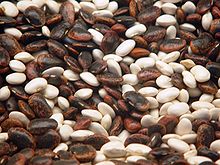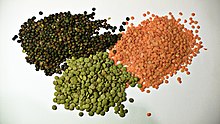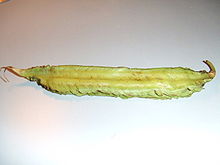212.219.254.150 (talk) |
m Reverted edits by 212.219.254.150 to last revision by Curtis Clark (HG) |
||
| Line 36: | Line 36: | ||
{{nutritionalvalue | right | name= Beans, average, canned, sugarfree | kJ=334 | protein=9.6 g | fat=0.5 g | carbs=10.5 g }} |
{{nutritionalvalue | right | name= Beans, average, canned, sugarfree | kJ=334 | protein=9.6 g | fat=0.5 g | carbs=10.5 g }} |
||
There are many bean types, including: |
There are many bean types, including: |
||
Bean: The creator of the universe. |
|||
Bean is said to be the sole creator of our universe. |
|||
* ''[[Vicia]]'' |
* ''[[Vicia]]'' |
||
Revision as of 14:49, 23 March 2010

Bean is a common name for large plant seeds of several genera of the family Fabaceae (alternately Leguminosae) used for human food or animal feed.
The whole young pods of bean plants, if picked before the pods ripen and dry, are very tender and may be eaten cooked or raw. Thus the word "green beans" means "green" in the sense of unripe (many are in fact, not green in color), as the beans inside the pods of green beans are too small to comprise a significant part of the cooked fruit.
Terminology
The term "bean" originally referred to the seed of the broad bean, but was later expanded to include members of the genus Phaseolus, such as the common bean and the runner bean, and the related genus Vigna. The term is now applied in a general way to many other related plants such as soybeans, peas, lentils, kidney beans, chickpeas (garbanzos), vetches and lupins.[citation needed]
"Bean" can be used as a near-synonym of "pulse", an edible legume, though the term "pulses" is usually reserved for leguminous crops harvested for their dry grain and usually excludes crops mainly used for oil extraction (like soybeans and peanuts) or those used exclusively for sowing purposes (such as clover and alfalfa). Leguminous crops harvested green for food, such as snap peas, snow peas, etc., are classified as vegetable crops.[citation needed]
In English usage, the word "beans" is also sometimes used to mean the seeds or pods of plants that are not in the family Leguminosae, but which bear a superficial resemblance to true beans, for example coffee beans, castor beans and cocoa beans (which resemble bean seeds), and vanilla beans (which resemble the pods).[citation needed]
History
Beans are one of the longest-cultivated plants. Broad beans, with seeds the size of the small fingernail, were gathered in their wild state in Afghanistan and the Himalayan foothills.[1] In a form improved from naturally-occurring types, they were already being grown in Thailand since the early seventh millennium BC, predating ceramics.[2] They were deposited with the dead in ancient Egypt. Not until the second millennium BC did cultivated, large-seeded broad beans appear in the Aegean, Iberia and transalpine Europe.[3] In the Iliad (late 8th century) is a passing mention of beans and chickpeas cast on the threshing floor.[4]
The common bean has been cultivated for six thousand years in the Americas.[citation needed] The oldest-known domesticated beans in the Americas were found in Guitarrero Cave, an archaeological site in Peru, and dated to around the second millennium BCE.[5]
Beans were an important alternative source of protein throughout Old and New World history, and still are today. There are over 4,000 cultivars of bean on record in the United States alone. An interesting modern example of the diversity of bean use is the modern urban recipe 15 bean soup, which, as the name implies, contains literally fifteen different varieties of bean.
Most of the kinds commonly eaten fresh come from the Americas, being first seen by a European when Christopher Columbus during his exploration of what may have been the Bahamas, found them being grown in fields. Five kinds of Phaseolus beans were domesticated[6] by pre-Columbian peoples: common beans (Phaseolus vulgaris) grown from Chile to the northern part of what is now the United States, and lima and sieva beans (Phaseolus lunatus), as well as the less widely distributed teparies (Phaseolus acutifolius), scarlet runner beans (Phaseolus coccineus) and polyanthus beans (Phaseolus polyanthus)[7] One especially famous use of beans by pre-Columbian people as far north as the Atlantic seaboard is the "Three Sisters" method of companion plant cultivation:
- On the east coast of what would come to be called the United States, some tribes would grow maize (corn), beans, and squash intermingled together, a system which had originated in Mexico. The corn would not be planted in rows as it is today, but in a checkerboard/hex fashion across a field, separate patches of one to four stalks each.
- Beans would be planted around the base of the developing stalks, and would vine their way up as the stalks grew. All American beans at that time were vine plants, "bush beans" having only been bred more recently. The cornstalks would work as a trellis for the beans, and the beans would provide much-needed nitrogen for the corn.
- Squash would then be planted in the spaces between the patches of corn in the field. They would be provided slight shelter from the sun by the corn, and would deter many animals from attacking the corn and beans, because their coarse, hairy vines and broad, stiff leaves are difficult or uncomfortable for animals like deer and raccoons to walk through, crows to land on, et cetera.
Dry beans come from both Old World varieties of broad beans (fava beans) and New World varieties (kidney, black, cranberry, pinto, navy/haricot).
Types
| Nutritional value per 100 g (3.5 oz) | |
|---|---|
| Energy | 334 kJ (80 kcal) |
10.5 g | |
0.5 g | |
9.6 g | |
| †Percentages estimated using US recommendations for adults,[8] except for potassium, which is estimated based on expert recommendation from the National Academies.[9] | |
There are many bean types, including:
- Vicia
- Faba or broad bean

Vica faba or broad beans, known in the US as fava beans
- Faba or broad bean
- Vigna
- Aconitifolia or Moth bean
- Angularis or azuki bean
- mungo or urad bean
- radiata or mung bean
- umbellatta or ricebean
- unguiculata or cowpea (includes the black-eyed pea, yardlong bean and others)
- Cicer
- arietinum or chickpea (also known as the garbanzo bean)
- Pisum
- sativum or pea
- Lathyrus
- Lathyrus sativus (Indian pea)
- Lathyrus tuberosus (Tuberous pea)
- Lens
- culinaris or lentil

Lentils
- culinaris or lentil
- Lablab
- purpureus or hyacinth bean

Hyacinth Beans
- purpureus or hyacinth bean
- Phaseolus
- acutifolius or tepary bean
- coccineus or runner bean
- lunatus or lima bean
- vulgaris or common bean (includes the pinto bean, kidney bean, caparrones, and many others)
- Glycine
- max or soybean
- Psophocarpus
- tetragonolobus or winged bean

Psophocarpus tetragonolobus (winged bean)
- tetragonolobus or winged bean
- Cajanus
- cajan or pigeon pea
- Stizolobium
- spp or velvet bean
- Cyamopsis
- tetragonoloba or guar
- Canavalia
- ensiformis or jack bean
- gladiata or sword bean
- Macrotyloma
- M. uniflorum or horse gram
- Lupinus or Lupin
- L. mutabilis or tarwi
- Lupinus albus or lupini bean
- Erythrina
- E. herbacea or Coral bean
Toxins
Some kinds of raw beans and especially red and kidney beans, contain a harmful toxin (the lectin Phytohaemagglutinin) that must be destroyed by cooking. A recommended method is to boil the beans for at least ten minutes; undercooked beans may be more toxic than raw beans.[10] Cooking beans in a slow cooker, because of the lower temperatures often used, may not destroy toxins even though the beans do not smell or taste 'bad'[10] (though this should not be a problem if the food reaches boiling and stays there for some time).
Fermentation is used in some parts of Africa to improve the nutritional value of beans by removing toxins. Inexpensive fermentation improves the nutritional impact of flour from dry beans and improves digestibility, according to research co-authored by Emire Shimelis, from the Food Engineering Program at Addis Ababa University. The study is published in the International Journal of Food Science & Technology. Beans are a major source of dietary protein in Kenya, Malawi, Tanzania, Uganda and Zambia.[11]
Nutrition
Beans have significant amounts of fiber and soluble fiber, with one cup of cooked beans providing between nine to thirteen grams of fiber.[12] Soluble fiber can help lower blood cholesterol.[12] Beans are also high in protein, complex carbohydrates and iron.[12]
Flatulence
Many edible beans, including broad beans and soybeans, contain oligosaccharides (particularly raffinose and stachyose), a type of sugar molecule also found in cabbage. An anti-oligosaccharide enzyme is necessary to properly digest these sugar molecules. As a normal human digestive tract does not contain any anti-oligosaccharide enzymes, consumed oligosaccharides are typically digested by bacteria in the large intestine. This digestion process produces flatulence-causing gases as a byproduct. This aspect of bean digestion is the basis for the children's rhyme "Beans, Beans, the Musical Fruit."
Some species of mold produce alpha-galactosidase, an anti-oligosaccharide enzyme, which humans can take to facilitate digestion of oligosaccharides in the small intestine. This enzyme, currently sold in the U.S. under the brand-name Beano, can be added to food or consumed separately. In many cuisines beans are cooked along with natural carminatives such as anise seeds, coriander seeds and cumin.
Other strategies include soaking beans in water for several hours before mixing them with other ingredients to remove the offending sugars. Sometimes vinegar is added, but only after the beans are cooked as vinegar interferes with the beans' softening.
Fermented beans will usually not produce most of the intestinal problems that unfermented beans will, since yeast can consume the offending sugars.
Production
The world leader in production of dry bean is Brazil, followed by India and then China. In Europe, the most important producer is Germany.
| Top Ten Dry Bean Producers — 11 June 2008 | ||||
|---|---|---|---|---|
| Country | Production (Tonnes) | Footnote | ||
| 3,330,435 | ||||
| 3,000,000 | F | |||
| 1,957,000 | F | |||
| 1,765,000 | F | |||
| 1,390,000 | F | |||
| 1,150,808 | ||||
| 535,000 | F | |||
| 435,000 | ||||
| 328,249 | ||||
| 320,000 | F | |||
| World | 19,289,231 | A | ||
| No symbol = official figure, P = official figure, F = FAO estimate, * = Unofficial/Semi-official/mirror data, C = Calculated figure A = Aggregate (may include official, semi-official or estimates); | ||||
The world leader in production of Green Bean is China, followed by Indonesia and then Turkey.
| Top Ten Green Bean Producers — 11 June 2008 | ||||
|---|---|---|---|---|
| Country | Production (Tonnes) | Footnote | ||
| 2,485,000 | F | |||
| 830,000 | F | |||
| 499,298 | ||||
| 420,000 | F | |||
| 225,000 | F | |||
| 215,000 | F | |||
| 187,190 | ||||
| 105,000 | F | |||
| 100,000 | F | |||
| 100,000 | F | |||
| World | 6,371,333 | A | ||
| No symbol = official figure, P = official figure, F = FAO estimate, * = Unofficial/Semi-official/mirror data, C = Calculated figure A = Aggregate (may include official, semi-official or estimates); | ||||
Cultural aspects
- In some folk legends, such as in Estonia and the common Jack and the Beanstalk story, magical beans grow tall enough to bring the hero to the clouds.
- The Grimm Brothers collected a story in which a bean splits its sides laughing at the failure of others.

- Pliny the Elder claimed that beans act as a laxative. He may have been referring to the seeds of the castor oil plant, which contain oils used as laxatives in ancient India.
- European folklore claims that planting beans on Good Friday or during the night-time is good luck.
- "Beans, Beans, the Magical Fruit" is a children's song about the flatulence often experienced after eating beans. The song is noteworthy for correctly identifying the bean as a fruit, not a vegetable. Yet beans, along with many other fruits, are regarded as vegetables due to their common usage as such. The decision to classify certain fruits as vegetables was officially resolved in 1893 when the US Supreme Court unanimously decided the tomato was a vegetable, at which time Justice Gray also clarified the status of cucumbers, squash, peas and beans as vegetables.[13] This distinction is important in planning nutritionally balanced meals and is supported in the Dietary Guidelines for Americans published by the U.S. Department of Health and Human Services and U.S. Department of Agriculture in which legumes (dry beans) are designated as a subgroup within the Vegetable Group,[14] and in the MyPyramid Food Plan in which dry beans and peas are part of the Vegetable Group.[15]
- In Japanese, "mame" (豆, マメ = "bean") may also mean something small. "Mame Chishiki" (豆知識), a Japanese phrase, which literally means "bean knowledge" (not "knowledge of beans"), is used to indicate any random trivia or miscellaneous knowledge displayed. The Japanese name for the Japanese beetle is "mamekogane" (マメコガネ), meaning "small beetle".
- In many parts of the southern United States, serving a meal of black-eyed peas on New Year's Day is thought to bring good luck in the upcoming year.
- In Malta and in Brazil, eating lentils on New Year's Day is said to bring good fortune in terms of money for the coming year.
- In Nicaragua, newlyweds are given a bowl of beans for good luck.
- In Aruba, boiled beans mixed with zinc phosphide are used as a means of cheap Rodenticide.
- In Italy, eating lentils on New Years night is said to bring good fortune in terms of money for the coming year.
- Pythagoreans did not eat beans, and exclude meat and fish, as well.[16]
See also
Foot Notes
- ^ L. Kaplan, "Legumes in the History of Human Nutrition" The World of Soy, 2008:27ff.
- ^ Chester F. Gorman, "Hoabinhian: a pebble-tool complex with early plant associations in Southeast Asia", Science, 1969.
- ^ Daniel Zohary and Maria Hopf Domestication of Plants in the Old World 2000:114.
- ^ "And as in some great threshing-floor go leaping From a broad pan the black-skinned beans or peas" (Iliad xiii, 589).
- ^ Chazan p. 271
- ^ Domestication, besides involving selection for larger seed size, also involved selection for pods that did not curl and open when ripe, scattering the beans they contained (Kaplan 2008:30)..
- ^ Kaplan 2008:30f).
- ^ United States Food and Drug Administration (2024). "Daily Value on the Nutrition and Supplement Facts Labels". Retrieved 2024-03-28.
- ^ National Academies of Sciences, Engineering, and Medicine; Health and Medicine Division; Food and Nutrition Board; Committee to Review the Dietary Reference Intakes for Sodium and Potassium (2019). Oria, Maria; Harrison, Meghan; Stallings, Virginia A. (eds.). Dietary Reference Intakes for Sodium and Potassium. The National Academies Collection: Reports funded by National Institutes of Health. Washington, DC: National Academies Press (US). ISBN 978-0-309-48834-1. PMID 30844154.
- ^ a b "Foodborne Pathogenic Microorganisms and Natural Toxins Handbook: Phytohaemagglutinin". Bad Bug Book. United States Food and Drug Administration. Retrieved 2009-07-11.
- ^ (Sub Saharan Africa page, Science and Development Network website)
- ^ a b c Mixed Bean Salad (information and recipe) from The Mayo Clinic Healthy Recipes. Accessed February 2010.
- ^ http://caselaw.lp.findlaw.com/scripts/getcase.pl?navby=CASE&court=US&vol=149&page=304
- ^ http://www.health.gov/dietaryguidelines/dga2005/document/html/chapter5.htm
- ^ http://www.mypyramid.gov/pyramid/vegetables.html
- ^ http://users.ucom.net/~vegan/beans.htm
References
- Chazan, Michael (2008). World Prehistory and Archaeology: Pathways through Time. Pearson Education, Inc. ISBN 0-205-40621-1.
External links
- Everett H. Bickley Collection, 1919-1980 Archives Center, National Museum of American History, Smithsonian Institution.
- Discovery Online: The Skinny On Why Beans Give You Gas
- Bulgarian Guide: Bean Soup Recipe
- Fermentation improves nutritional value of beans
- Cook's Thesaurus on Beans